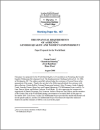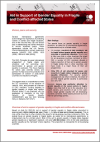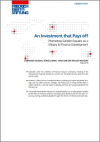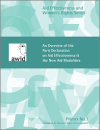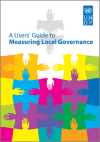FOUND 83 RESULTS
This paper by the Commonwealth Secretariat (1999) provides a rationale for the strategic goals of the Commonwealth Gender Budget Initiative at the national level and highlights the need for integrating a gender perspective in macroeconomic policies and budgets. In addition, the paper outlines the necessary tools required for a gender analysis of the budget and the results from pilot initiatives in Sri Lanka and South Africa.
The report provides a snapshot of the landscape of global human rights grantmaking in 2014.
The paper provides a comprehensive overview and guide to complex issue of linkages between aid and gender equality. Moreover, the position paper addresses the intricate linkages and identifies existing challenges for future action in development practice and research with a view to increasing aid efficiency.
The report prepared by the OECD DAC provides statistics on aid focused on gender equality and women's empowerment extended by DAC members. The statistics are basedon Members' reporting on the Gender Equality Policy Marker. Information includes the share of aid focussed on gender equality, top ten recipients, a sector breakdown and marker coverage for each DAC donor.
The present study is a contribution to mark the 10th anniversary of the adoption of UNSCR 1325, and provides an overview of DAC members' funding targeted to gender equality in fragile and conflict-affected states. It was prepared with the assistance of members of the DAC Network on Gender Equality (GENDERNET) and the DAC Working Party on Statistics (WP-STAT). The main findings of the study are, On average, one-third of DAC members' aid to fragile states targets gender equality as a principal or...
This paper identifies the linkages between gender equality and financing for development, with an eye to connecting these results to concrete policy implications that can be adopted by developing countries to ensure a win-win outcome: greater gender equality, resource mobilization, and improvements in societal well-being. Under the conditions of financial resource constraints, especially, investing in the improvement of gender equality in a country can stimulate economic growth for the whole...
This first primer of the AWID Aid Effectiveness and Women's Rights Series published in 2008 provides an overview of the Paris Declaration on Aid Effectiveness and the subsequent new aid modalities that have emerged from donor discussions to foster a more effective and efficient use of resources for financing development.
This Guide was preared by Alexandra Wilde, Shipra Narang, Marie Laberge and Luisa Moretto UNDP Oslo, 2009. The publication compiles existing knowledge on decentralization and local governance measurement and provide a platform for understanding and navigating the array of assessment tools that exist, focusing on particular issues such how to select amongst the existing (or decide to design a new set of) local governance indicators; how to deal with the preparation and launching of an assessment;...
This third primer in the AWID Aid Effectiveness and Women's Rights series focuses on describing how the parallel tracking process is being undertaken independently by CSOs and, most recently, some women's rights organizations. This primer seeks first to provide a background and overview of this parallel process, then identifies some pressing concerns, and lastly presents some recommendations from the civil society perspective.
The monitoring and evaluation process of implementation of the Paris Declaration has been broadly debated among civil society organizations involved in the aid effectiveness process. This primer prepared by the Association for Women's Rights in Development (AWID) in 2008 presents a general overview of this process, the key results of the first official round of monitoring, and the main concerns and recommendations put forward by CSOs participating in the parallel process towards the HLF3. The...


